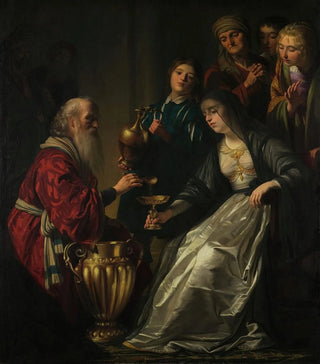Art print | Artemisia - Gerard van Honthorst


View from behind

Frame (optional)
Artemisia Art print - Gerard van Honthorst – Captivating Introduction
The "Artemisia" art print by Gerard van Honthorst is a true masterpiece that immerses the viewer in the fascinating world of the 17th century. This painting, highlighting the iconic figure of the painter Artemisia Gentileschi, is a celebration of female strength and creativity. Honthorst, renowned for his masterful use of light and shadow, succeeds in capturing the very essence of his subject, evoking intense emotions and remarkable psychological depth. Contemplating this work, one is immediately transported to a time when art was a powerful means of expression, capable of transcending social conventions and giving voice to women artists.
Style and uniqueness of the art print
Honthorst's style is distinguished by its baroque approach, characterized by striking contrasts between light and darkness, a technique often referred to as chiaroscuro. In "Artemisia," the light seems to emanate from within the artwork itself, illuminating the protagonist's face while gently shading the rest of the composition. This skillful use of light not only enhances the drama of the scene but also highlights the intricate details of the clothing and expressions. Artemisia's posture, both strong and vulnerable, reflects the complexity of her character, while also mirroring the struggles and triumphs of women of her time. Honthorst thus manages to create an atmosphere that is both intimate and universal, inviting the viewer to reflect on the role of the artist and the nature of inspiration.
The artist and his influence
Gerard van Honthorst, born in Utrecht, is a painter who made a name for himself in the art world thanks to his undeniable talent and innovative approach. Raised during a period when the baroque style was dominant, he was influenced by masters such as Caravaggio, whose chiaroscuro techniques profoundly impacted his work. Honthorst also had the opportunity to travel to Italy, where he absorbed local styles and artistic innovations. His interest in narrative subjects and portraits allowed

Matte finish

View from behind

Frame (optional)
Artemisia Art print - Gerard van Honthorst – Captivating Introduction
The "Artemisia" art print by Gerard van Honthorst is a true masterpiece that immerses the viewer in the fascinating world of the 17th century. This painting, highlighting the iconic figure of the painter Artemisia Gentileschi, is a celebration of female strength and creativity. Honthorst, renowned for his masterful use of light and shadow, succeeds in capturing the very essence of his subject, evoking intense emotions and remarkable psychological depth. Contemplating this work, one is immediately transported to a time when art was a powerful means of expression, capable of transcending social conventions and giving voice to women artists.
Style and uniqueness of the art print
Honthorst's style is distinguished by its baroque approach, characterized by striking contrasts between light and darkness, a technique often referred to as chiaroscuro. In "Artemisia," the light seems to emanate from within the artwork itself, illuminating the protagonist's face while gently shading the rest of the composition. This skillful use of light not only enhances the drama of the scene but also highlights the intricate details of the clothing and expressions. Artemisia's posture, both strong and vulnerable, reflects the complexity of her character, while also mirroring the struggles and triumphs of women of her time. Honthorst thus manages to create an atmosphere that is both intimate and universal, inviting the viewer to reflect on the role of the artist and the nature of inspiration.
The artist and his influence
Gerard van Honthorst, born in Utrecht, is a painter who made a name for himself in the art world thanks to his undeniable talent and innovative approach. Raised during a period when the baroque style was dominant, he was influenced by masters such as Caravaggio, whose chiaroscuro techniques profoundly impacted his work. Honthorst also had the opportunity to travel to Italy, where he absorbed local styles and artistic innovations. His interest in narrative subjects and portraits allowed






